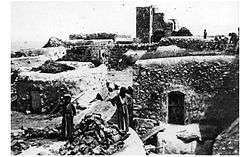Hulayqat
| Hulayqat | |
|---|---|
|
Hulayqat, before 1948 | |
| Arabic | حليقات |
| Name meaning | the circles[1] |
| Subdistrict | Gaza |
| Palestine grid | 116/112 |
| Population | 420[2] (1945) |
| Date of depopulation | May 12, 1948[3] |
| Cause(s) of depopulation | Influence of nearby town's fall |
Hulayqat was a Palestinian Arab village in the Gaza Subdistrict. It was depopulated during the 1947–1948 Civil War in Mandatory Palestine. It was located 20.5 km northeast of Gaza.
History
Hulayqat had numerous khirbas which contained cisterns, a pool, and fragments of marble and pottery.[4]
Ottoman era
In 1883, the Palestine Exploration Fund's Survey of Western Palestine described it as a "small village on a flat slope, with a high sandy hill to the west. It has cisterns and a pond, with a small garden to the west.”[5]
British Mandate era
In the 1922 census of Palestine, conducted by the British Mandate authorities, Hukiqat had a population of 251 inhabitants, all Muslims,[6] increasing in the 1931 census to 285, still all Muslims, in 61 houses.[7]
In 1945 Huleiqat had a population of 420 Muslims,[2] with a total of 7,063 dunams of land, according to an official land and population survey.[8] Of this, 115 dunams were used for plantations and irrigable land, 6,636 for cereals,[9] while they had 18 dunams as built-up land.[10]
In 1947, an oil drilling project commenced in Hulayqat employing 300 Arab workers.[11]
1948, aftermath
The village was first captured by the Israeli army on 13 May during Operation Barak and depopulated.[12][13] On 8 July, it was retaken by the Egyptian army. A well-fortified battalion of the 4th Brigade was stationed there later reinforced by more troops.[14] and some of the villagers returned to their homes. It was finally captured on 19 October by the Giv'ati Brigade during Operation Yoav.[4]
According to the Palestinian historian Walid Khalidi, the ruin of the village in 1992 was partially forested with sycamore, Christ's-thorn trees and cactus. One of the old roads had been paved.[4]
See also
References
- ↑ Palmer, 1881, p. 367
- 1 2 Department of Statistics, 1945, p. 31
- ↑ Morris, 2004, p. xix, village #317. Also gives cause for depopulation
- 1 2 3 Khalidi, 1992, p. 104
- ↑ Conder and Kitchener, 1883, SWP III, p. 260
- ↑ Barron, 1923, Table V, Sub-district of Gaza, p. 8
- ↑ Mills, 1932, p. 3
- ↑ Government of Palestine, Department of Statistics. Village Statistics, April, 1945. Quoted in Hadawi, 1970, p. 45
- ↑ Government of Palestine, Department of Statistics. Village Statistics, April, 1945. Quoted in Hadawi, 1970, p. 87
- ↑ Government of Palestine, Department of Statistics. Village Statistics, April, 1945. Quoted in Hadawi, 1970, p. 137
- ↑ Drilling begins near Gaza
- ↑ Tal, 2004, p. 174
- ↑ Morris, 2004, p. 258
- ↑ Tal, 2004, p. 385
Bibliography
- Barron, J. B., ed. (1923). Palestine: Report and General Abstracts of the Census of 1922. Government of Palestine.
- Conder, Claude Reignier; Kitchener, H. H. (1883). The Survey of Western Palestine: Memoirs of the Topography, Orography, Hydrography, and Archaeology. 3. London: Committee of the Palestine Exploration Fund.
- Department of Statistics (1945). Village Statistics, April, 1945. Government of Palestine.
- Hadawi, Sami (1970). Village Statistics of 1945: A Classification of Land and Area ownership in Palestine. Palestine Liberation Organization Research Center.
- Khalidi, Walid (1992). All That Remains: The Palestinian Villages Occupied and Depopulated by Israel in 1948. Washington D.C.: Institute for Palestine Studies. ISBN 0-88728-224-5.
- Mills, E., ed. (1932). Census of Palestine 1931. Population of Villages, Towns and Administrative Areas (PDF). Jerusalem: Government of Palestine.
- Morris, Benny (2004). The Birth of the Palestinian Refugee Problem Revisited. Cambridge University Press. ISBN 978-0-521-00967-6.
- Palmer, E. H. (1881). The Survey of Western Palestine: Arabic and English Name Lists Collected During the Survey by Lieutenants Conder and Kitchener, R. E. Transliterated and Explained by E.H. Palmer. Committee of the Palestine Exploration Fund.
- Tal, David (2004). War in Palestine, 1948: Israeli and Arab Strategy and Diplomacy. Routledge. ISBN 0-7146-5275-X.
External links
- Welcome To Hulayqat
- Survey of Western Palestine, Map 20: IAA, Wikimedia commons
- Hulayqat, from the Khalil Sakakini Cultural Center
Coordinates: 31°35′53″N 34°38′59″E / 31.59806°N 34.64972°E
